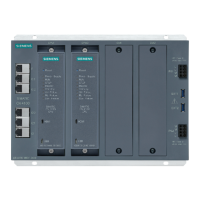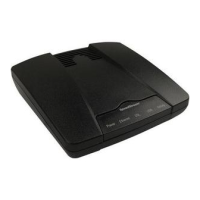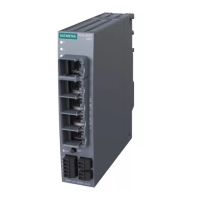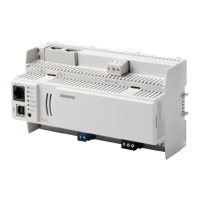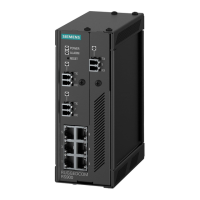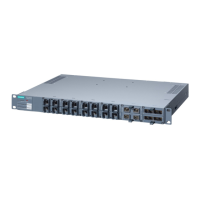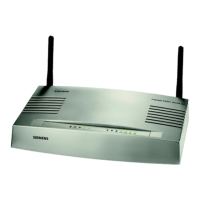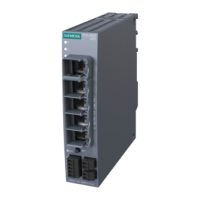Do you have a question about the Siemens 4100 Series and is the answer not in the manual?
Details the router's capabilities including LAN features, security, and management.
Lists the necessary computer hardware and software for router installation.
Provides essential safety precautions for using the router.
Covers positioning, basic setup, line filter installation, and cable connections.
Specific steps for installing the router using a USB connection.
Verifies correct TCP/IP configuration for computer to work with the router.
Guides on configuring web browser for Internet access via LAN.
Steps to establish a connection from a computer to the router via web browser.
Details on selecting and logging into PPP connections, including options.
Description of the router's main interface after initial startup.
Instructions for creating new user profiles to control router and network access.
Steps to modify existing user profiles and their settings.
Procedure for removing user profiles from the router configuration.
Wizard for configuring the Wide Area Network interface with ISP-provided information.
Configuration of router's network identity, IP address, netmask, and hostname.
Configuration for Dynamic Host Configuration Protocol for network address assignment.
Configuration for RFC2684 WAN-side connections using DHCP client.
Activation and control of Routing Information Protocol for determining network paths.
Enables external access to internal servers and automatic device discovery.
Configures router to bridge mode and specifies ports for common applications.
Sets up Dynamic DNS to translate IP addresses into alphanumeric domain names.
Manages administrator login name, password, and security level requirements.
Configures the router to synchronize its date and time with network time servers.
Configures Network Address Translation (NAT) and NAPT for exposing LAN hosts to WAN.
Provides access to firewall settings like Level, Snooze, DMZ, Filter Rules, Log, and ADS.
Sets the firewall security level to Off, Low, Medium, High, ICSA-Compliant, or Custom.
Allows definition of custom inbound and outbound firewall rules based on various criteria.
Configures the Attack Detection System (ADS) to protect against and log network attacks.
Displays system summary, log, and network interface statistics.
Runs diagnostic programs to test LAN and WAN connectivity.
Provides utilities like Interface Map, Reboot, and Firmware Update.
Initial steps and LED guide for resolving common router issues.
Provides solutions for common problems indicated by LED status or errors.
Information on how to contact Efficient Networks Technical Support for assistance.
Details the router's capabilities including LAN features, security, and management.
Lists the necessary computer hardware and software for router installation.
Provides essential safety precautions for using the router.
Covers positioning, basic setup, line filter installation, and cable connections.
Specific steps for installing the router using a USB connection.
Verifies correct TCP/IP configuration for computer to work with the router.
Guides on configuring web browser for Internet access via LAN.
Steps to establish a connection from a computer to the router via web browser.
Details on selecting and logging into PPP connections, including options.
Description of the router's main interface after initial startup.
Instructions for creating new user profiles to control router and network access.
Steps to modify existing user profiles and their settings.
Procedure for removing user profiles from the router configuration.
Wizard for configuring the Wide Area Network interface with ISP-provided information.
Configuration of router's network identity, IP address, netmask, and hostname.
Configuration for Dynamic Host Configuration Protocol for network address assignment.
Configuration for RFC2684 WAN-side connections using DHCP client.
Activation and control of Routing Information Protocol for determining network paths.
Enables external access to internal servers and automatic device discovery.
Configures router to bridge mode and specifies ports for common applications.
Sets up Dynamic DNS to translate IP addresses into alphanumeric domain names.
Manages administrator login name, password, and security level requirements.
Configures the router to synchronize its date and time with network time servers.
Configures Network Address Translation (NAT) and NAPT for exposing LAN hosts to WAN.
Provides access to firewall settings like Level, Snooze, DMZ, Filter Rules, Log, and ADS.
Sets the firewall security level to Off, Low, Medium, High, ICSA-Compliant, or Custom.
Allows definition of custom inbound and outbound firewall rules based on various criteria.
Configures the Attack Detection System (ADS) to protect against and log network attacks.
Displays system summary, log, and network interface statistics.
Runs diagnostic programs to test LAN and WAN connectivity.
Provides utilities like Interface Map, Reboot, and Firmware Update.
Initial steps and LED guide for resolving common router issues.
Provides solutions for common problems indicated by LED status or errors.
Information on how to contact Efficient Networks Technical Support for assistance.
| Product Series | 4100 Series |
|---|---|
| Category | Network Router |
| Manufacturer | Siemens |
| Ports | Varies by model (e.g., 4x 10/100/1000Base-T, SFP slots) |
| Interface Types | Ethernet |
| Supported Protocols | TCP, SNMP, RIP, OSPF |
| Security Features | Firewall, VPN, Access Control |
| Management | Web-based interface, Command-Line Interface (CLI), SNMP |

